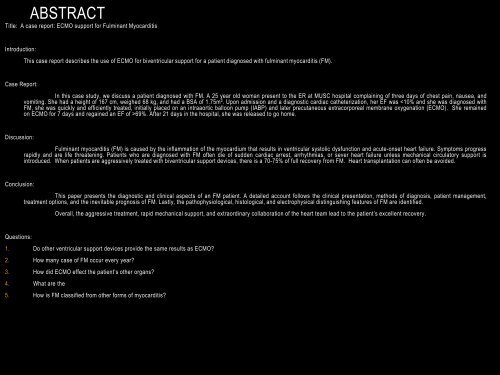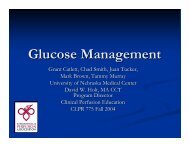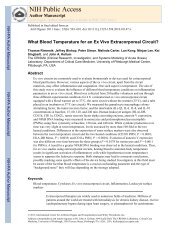PowerPoint Presentation (PDF) - Perfusion.com
PowerPoint Presentation (PDF) - Perfusion.com
PowerPoint Presentation (PDF) - Perfusion.com
You also want an ePaper? Increase the reach of your titles
YUMPU automatically turns print PDFs into web optimized ePapers that Google loves.
ABSTRACT<br />
Title: A case report: ECMO support for Fulminant Myocarditis<br />
Introduction:<br />
This case report describes the use of ECMO for biventricular support for a patient diagnosed with fulminant myocarditis (FM).<br />
Case Report:<br />
In this case study, we discuss a patient diagnosed with FM. A 25 year old woman present to the ER at MUSC hospital <strong>com</strong>plaining of three days of chest pain, nausea, and<br />
vomiting. She had a height of 167 cm, weighed 68 kg, and had a BSA of 1.75m². Upon admission and a diagnostic cardiac catheterization, her EF was 69%. After 21 days in the hospital, she was released to go home.<br />
Discussion:<br />
Fulminant myocarditis (FM) is caused by the inflammation of the myocardium that results in ventricular systolic dysfunction and acute-onset heart failure. Symptoms progress<br />
rapidly and are life threatening. Patients who are diagnosed with FM often die of sudden cardiac arrest, arrhythmias, or sever heart failure unless mechanical circulatory support is<br />
introduced. When patients are aggressively treated with biventricular support devices, there is a 70-75% of full recovery from FM. Heart transplantation can often be avoided.<br />
Conclusion:<br />
This paper presents the diagnostic and clinical aspects of an FM patient. A detailed account follows the clinical presentation, methods of diagnosis, patient management,<br />
treatment options, and the inevitable prognosis of FM. Lastly, the pathophysiological, histological, and electrophysical distinguishing features of FM are identified.<br />
Overall, the aggressive treatment, rapid mechanical support, and extraordinary collaboration of the heart team lead to the patient’s excellent recovery.<br />
Questions:<br />
1. Do other ventricular support devices provide the same results as ECMO?<br />
2. How many case of FM occur every year?<br />
3. How did ECMO effect the patient’s other organs?<br />
4. What are the<br />
5. How is FM classified from other forms of myocarditis?
















